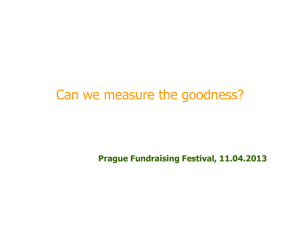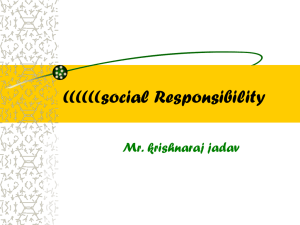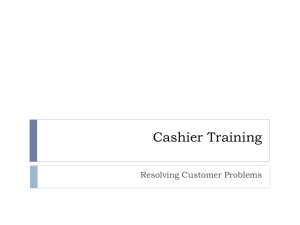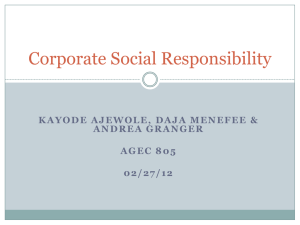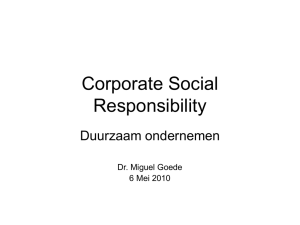MGT 704 ปรัชญาและจริยธรรมของการจัดการยุคใหม่
advertisement
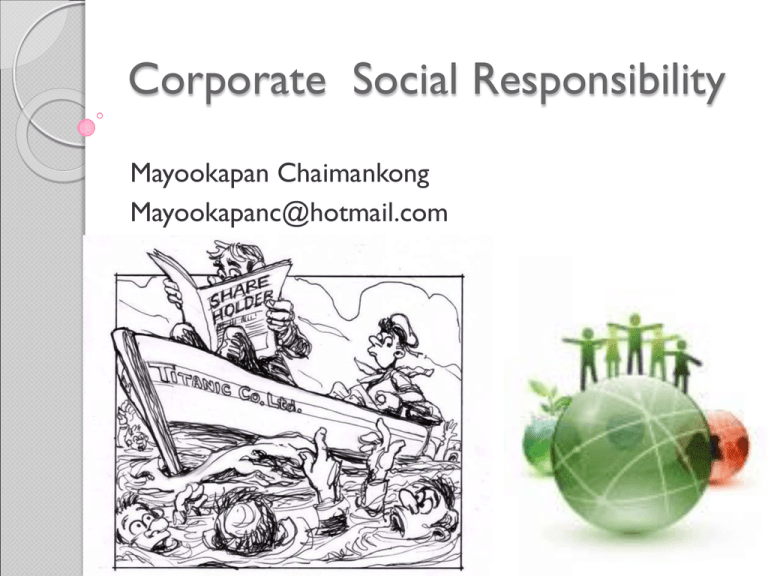
Corporate Social Responsibility Mayookapan Chaimankong Mayookapanc@hotmail.com Corporate Social Responsibility Discussion: 1) รู ปแบบ CSR ที่ท่านเคยเห็น 2) Motive ของ Firm ที่ทา CSR ดังกล่ าว 3) ภาพรวมท่ านคิดเห็นต่ อ CSR ที่ยกตัวอย่ างมาอย่ างไร CSR VS CG ผูถ้ ือหุน้ ผูบ้ ริหาร พนักงาน ลูกค้า คู่คา้ ครอบครัวของพนักงาน ชุมชนที่องค์กรตั้งอยู่ สิง่ แวดล้อมรอบข้าง ประชาชนทั ่วไป คู่แข่งขันทางธุรกิจ Source: สถาบันไทยพัฒน์ Defining CSR What is CSR? Lack of a widely agreed definition Defining CSR: CSR as an ethical stance Mintzberg stated that CSR can be practised in four forms 1) Purest form: Firm expects nothing back 2) Enlightened self interest: Undertake CSR with the belief that CSR pay 3) Sound investment: Undertake CSR will be rewarded by the market 4) Avoid Interference: Prevent authorities forcing them to do so via legislation Defining CSR: CSR as an ethical stance Apart from the purest form, Mintzberg sees the others not as ethical stance as it raises greed The proponents of this view include Moore (2003), Goyder (2003) and Jone (2003) Defining CSR: CSR as business strategy Ideas originates from Agency Theory Agency Theory: managers are agents of the stockholders and should therefore give priority to serving them by maximize financial gains Implication: manager should not engage in any acts that deteriorate shareholder wealth Friedman (1970) and Henderson (2001, 2004) have argued that CSR is a dangerous concept as its threaten the basic of principle of market economy Defining CSR: CSR as business strategy Many others believe that CSR can become a useful tool to maximize shareholders wealth Lantos (2001, 2002) purposed that CSR should focused on two aspects 1) Prevent injuries and harm form business activities 2) Accomplishing strategic business goals Defining CSR: CSR as business strategy Carroll (1979) purpose ‘Four faces’ of responsibility to fully address the entire range of obligations business has to society Economic: the first and foremost responsibility Legal: obligation to abide the law Ethical: Doing beyond law requirement Discretionary: Philanthropic contribution Firm will use CSR to devise a strategy to enhance overall business performance Carroll’s Pyramid of Social Responsibility Philanthropic Ethical Legal Economic Defining CSR: CSR as business strategy Schwartz and Carroll (2003) purpose ‘Three domain model’ which built upon Carroll pyramid model Discretionary is disappeared as the author believe that discretionary is an option, not obligation. However discretionary acts can be undertaken for economic and ethical motive (i.e. strategically) They argued that the best business strategy lies in the overlap area Three domain model: The multiple responsibilities of business Economic Responsibility Social Responsibility Legal Responsibility CSR: Serving Stakeholders Regardless of the views, the way stakeholders are treat take central stage. CSR as Ethical stance: The company treat stakeholder ethically due to the belief that it is a noble way to behave CSR as Strategy: Stakeholder are treated ethically to make business prosper The Evolving Idea of Social Responsibility The fundamental idea is that corporations have duties that go beyond carrying out their basic economic function in a lawful manner. Over time the doctrine has evolved to require more expansive action by companies largely because: ◦ Stakeholder groups have gained more power to impose their agendas ◦ The ethical and legal philosophies underlying it have matured Social Responsibility in Classical Economic Theory Adam Smith introduced the expression of “ invisible hand” in 1770s Invisible hand brought about economic prosperity and social benefits even though their real intentions were the pursuit of self-interest. In other words, Social welfare is the by-product of capitalist activities Implication: Firm operating to maximize profit within the law. The beginning of CSR In US, the idea of CSR appeared around the 19th Century. Firms came under attack for being to big, too powerful, and guilty of antisocial practices A few far farsighted business executive began to use their power for broad social purpose The Early Charitable Impulse Steven Girard changed the climate of education in the United States by donating $6 million for a school to educate orphaned boys. John D. Rockefeller systematically gave away $550 million over his lifetime. Henry Ford developed paternalistic programs to support the recreational and health needs of his employees The Early Charitable Impulse Andrew Carnegie gave $350 million over his lifetime to causes that would elevate the culture of a society. Two traditional principle of CSR The Charitable principle: the wealthier members of society should be charitable toward those less fortunate The Stewardship principle: Act as stewards or trustees, act in general public interest Two traditional principle of CSR Foundation principles of corporate social responsibility and their modern expression. Charity Principles Stewardship Principle Definition Business should give voluntary aid to society’s needy persons and groups. Business, acting as a public trustee, should consider the interests of all who are affected by business decisions and policies. Modern Expression • Corporate philanthropy • Acknowledging business and society interdependence • Voluntary actions to promote the social good • Balancing the interests and needs of many diverse groups in society Examples • Corporate philanthropic foundations • Enlightened self-interest • Meeting legal requirements • Private initiatives to solve social problems • Employee volunteerism • Stakeholder approach to corporate strategic planning Recommended social responsibility action Recommended social responsibility actions – Committee for Economic Development. Source: Social Responsibilities of Business Corporations (New York: Committee for Economic Development, 1971). Economic growth and efficiency Improving productivity Cooperating with government Pollution abatement Installing pollution controls Developing recycling programs Education Giving aid to schools and colleges Assisting in managing schools and colleges Conservation and recreation Protecting plant and animal ecology Restoring depleted lands to use Employment and training Training disadvantaged workers Retraining displaced workers Civil rights and equal opportunity Ensuring equal job opportunities Urban renewal and development Building low-income housing Improving transportation systems Culture and the arts Giving aid to art institutions Medical care Helping community health planning Designing low-cost medical care programs Government Improving management in government Modernizing and reorganizing government CSR Classification (By activities) CSR in Thailand ผลจากรายงาน "สารวจสถานการณ ์ CSR ในประเทศไทยปี พ.ศ.2549 ผาน ่ การประชาสั มพันธจากนิ ตยสาร Positioning หัวขอ ์ ้ CSR ของ "โชษิตา ตัน ฉาย“ รูปแบบของ cause philanthropy หรือการบริจาคถูกนามาใช้มากทีส ่ ุดในปี พ.ศ.2549 คิดเป็ น 52.5% รองลงมาคือ รูปแบบ cause promotion หรือ การส่งเสริมการตลาดผาน ่ กิจกรรมเพือ ่ สั งคม 29.6% ตามดวย corporate social marketing การสนับสนุ นโครงการทีท ่ าให้ ้ บุคคลเกิดการเปลีย ่ นแปลงพฤติกรรมในเรือ ่ งทีเ่ กิดประโยชนต ์ อสั ่ งคม โดยใช้ ส่วนผสมทางการตลาดและการสื่ อสาร 9.5% cause related marketing การบริจาคเงินจากส่วนแบงของสิ นคาภายใน ่ ้ ช่วงเวลาทีก ่ าหนดให้กับสั งคม 9.5% CSR in Thailand socially responsible business practice การลงทุนหรือการเปลีย ่ นแปลงการ ดาเนินงานของบริษท ั เพือ ่ แสดงให้เห็นถึงความรับผิดชอบตอสั ่ งคมในทุก กระบวนการขององคกร ตัง้ แตการดู แลพนักงาน จนถึงกระบวนการผลิต และ ์ ่ การดาเนินงานทีโ่ ปรงใส 2.2% ่ community volunteering กิจกรรมพนักงานอาสาสมัคร 0.6% Cause Promotions Provides funds, in-kind contributions, or other organization resources to increase awareness and concern about a social cause Cause Related Marketing Commits to making a contribution or donating a percentage of revenues to a specific cause based on product sales e.g. donate 10% of the price of each product sold Cause Related Marketing RED Campaign Example It is the first time that the world’s leading companies have made a commitment to channel a portion of their profits from sales of speciallydesigned products to the Global Fund to support AIDS programs for women and children in Africa. Social Marketing Supports the development and/or implementation of a behavior change campaign e.g. Non-smoking campaign, No plastic bag Corporate Philanthropy Makes a direct contribution to a charity or cause, most often in the form of cash grant, donations and/or in-kind service Community Volunteering Supports and encourages employees, retail partners, and/or franchise members to volunteer their time to support local community organization and causes Community Volunteering Socially responsible business practices Adopts and conducts discretionary business practices and investments that support social causes to improve community well-being and protect the environment e.g. community trade, environmental friendly process Socially responsible business practices Socially responsible business practices Starbucks example CSR Classification (By process) CSR after process: CSR that separated from business operation Legitimacy CSR in Process: Incorporate social responsibility in business operation CSR as Process: non profit organization CSR Classification (By Resource) Corporate driven CSR: CSR that use the resource from within e.g. employee volunteers Social Driven CSR: CSR that use the resource from outside e.g. cause related promotion Corporate Social Responsibility Guideline and standards There are number of CSR guideline and standards (Both International & Local) - UN Global compact - OECD - ISO 26000 - SEC เข็มทิศธุรกิจ Responsibility Guidelines The United Nations and the Global Compact The Global Compact is a way of getting companies to voluntarily apply widely agreed upon principles to individual situations. Global Compact A set of 10 voluntary principles based on international norms administered by the United Nations. Member companies are to follow the principles in every country in which they do business. The United Nations and the Global Compact OECD Guideline เข็มทิศธุรกิจ Responsibility Guidelines สาหรับแนวปฏิบต ั ใิ นเรือ ่ ง CSR แบงได เป็ ่ ้ น 8 หัวขอ ้ ดังนี้ 1. การกากับดูแลกิจการทีด ่ ี 2. การประกอบุรกิจดวยความเป็ นธรรม ้ 3. การเคารพสิ ทธิและการปฏิบต ั ต ิ อแรงงานอย างเป็ นธรรม ่ ่ 4. ความรับผิดชอบตอผู ่ บริ ้ โภค 5. การรวมพั ฒนาชุมชนและสั งคม ่ 6. การดูแลรักษาสิ่ งแวดลอม ้ 7. การเผยแพรนวั ่ ตกรรมจากการดาเนินความรับผิดชอบตอสั ่ งคม 8. การจัดทารายงานดานสั งคมและสิ่ งแวดลอม ้ ้ เข็มทิศธุรกิจ Responsibility Guidelines 1. การกากับดูแลกิจการที่ ดี หลักการ การกากับดูแลกิจการทีด ่ ี เป็ นการจัดให้มีระบบบริหารจัดการทีม ่ ป ี ระสิ ทธิภาพ โปรงใส ่ ตรวจสอบได้ ซึ่งจะช่วยสรางความเชื อ ่ มัน ่ และความมัน ่ ใจตอผู น ผู้ ้ ่ ถื ้ อหุ้น ผูลงทุ ้ มีส่วนไดเสี ่ วของทุ กฝ่าย ซึ่งนาไปสู่ความเติบโตและเสถียรภาพทาง ้ ย และผูเกี ้ ย ้ เศรษฐกิจอยางยั ง่ ยืนของธุรกิจ ่ 2. การประกอบธุรกิจด้วยความเป็ นธรรม หลักการ การประกอบธุรกิจดวยความเป็ นธรรมยอมก อให ่ มัน ่ กับผูเกี ่ วของ ้ ่ ่ ้เกิดความเชือ ้ ย ้ อันจะส่งผลดีตอกิ ั ต ิ ามแนวทาง ่ จการในระยะยาว ทัง้ นี้ ธุรกิจควรถือปฏิบต เพือ ่ ให้เกิดความเป็ นธรรมในการดาเนินธุรกิจ โดยไมเห็ อื ่ ที่ ่ นแกผลประโยชน ่ ์ น อาจไดมาจากการด าเนินงานทีไ่ มถู านองคลองธรรม ้ ่ กตองตามท ้ เข็มทิศธุรกิจ Responsibility Guidelines 3. การเคารพสิทธิและการปฏิบต ั ิ ต่อแรงงานอย่างเป็ นธรรม หลักการ ทรัพยากรบุคคลเป็ นปัจจัยสาคัญของธุรกิจในการสรางมู ลคาเพิ ่ และเพิม ่ ผลผลิต ้ ่ ม ดังนั้น ธุรกิจควรปรับปรุงสภาพแวดลอมและเงื อ ่ นไขในการทางาน ให้พนักงานมี ้ คุณภาพชีวต ิ ทีด ่ ี และไดมี ้ โอกาสแสดงศั กยภาพ ตลอดจนไดรั ้ บโอกาสในการ ฝึ กฝนและเพิม ่ พูนทักษะในการทางาน 4. ความรับผิดชอบต่อผูบ ้ ริโภค หลักการ สิ นคา้ และ/หรือ บริการของธุรกิจไมควรก อให ่ ่ ้เกิดความเสี่ ยงหรืออันตรายตอ ่ ผูบริ ้ โภค ทัง้ นี้ ธุรกิจควรปรับปรุงมาตรฐานของสิ นคา้ และ/หรือบริการให้มีความเป็ นสากล และให้ทุกคนสามารถเขาถึ ่ เป็ น ้ งได้ รวมทัง้ ควรพัฒนาสิ นคา้ และ/หรือบริการเพือ ประโยชนในการช ญหาของสั งคมดวย ์ ่ วยแกไขปั ้ ้ Responsibility Guidelines 5. การร่วมพัฒนาชุมชนและสังคม หลักการ ชุมชนและสั งคมทีเ่ ขมแข็ ง และมีการพัฒนาทีย ่ ง่ ั ยืนนั้น มีความสาคัญยิง่ ในฐานะเป็ น ้ ปัจจัยเอือ ้ ตอการด าเนินงานของธุรกิจ ดังนั้น ธุรกิจควรจัดกิจกรรมทางสั งคม และ/ ่ หรือ มีส่วนรวมในการส งให้แกชุ ่ ่ งเสริมความเขมแข็ ้ ่ มชนและสั งคมทีไ่ ดรั ้ บผลกระทบ จากกระบวนการผลิตสิ นคาและ/หรื อ บริการของธุรกิจโดยการแสดงตัวเป็ นพลเมืองทีด ่ ี ้ ของชุมชนนั้น พรอมกั บคิดคนวิ ี ารทีจ ่ ะลดและหยุดผลกระทบในทางลบตอชุ ้ ้ ธก ่ มชนและ สั งคม ทีเ่ กิดจากกระบวนการดาเนินงานของธุรกิจในทีส ่ ุด 6. การดูแลรักษาสิ่งแวดล้อม หลักการ การเพิม ่ ขึน ้ ของจานวนประชากรโลก บวกกับปัจจัยความเจริญเติบโตทางเศรษฐกิจ นอกจากเป็ นสาเหตุของการบริโภคทรัพยากรธรรมชาติจานวนมหาศาลจนเกินกวาความ ่ จาเป็ นยังกอให ่ ้เกิดมลภาวะทัง้ ทางน้า อากาศ ขยะ สารพิษ ฯลฯ ซึ่งส่งผลให้เกิด ภาวะโลกรอนตามมาโดยภาวะโลกร อนดั งกลาวจะกระทบต อมนุ ษยและระบบนิ เวศนต ้ ้ ่ ่ ์ ์ อไป ่ ดังนั้น ธุรกิจจึงมีหน้าทีใ่ นการปรับปรุงคุณภาพชีวต ิ มนุ ษยด ดการปัญหา ์ วยการจั ้ สิ่ งแวดลอม โดยถือวาการดู แลรักษาสิ่ งแวดลอมเป็ นหน้าทีร่ วมกั นของทุกคน ้ ่ ้ ่ Responsibility Guidelines 7. การเผยแพร่นวัตกรรมจากการดาเนินความรับผิดชอบต่อสังคม หลักการ ในการดาเนินธุรกิจสามารถนาแนวคิด CSR มาประยุกตผสมผสานกั บการวางแผน ์ กลยุทธทางธุ รกิจไดอย น โดยการพัฒนาความรูที ์ ้ างกลมกลื ่ ้ เ่ กิดจากประสบการณการ ์ ดาเนินงานดาน CSR และนามาปรับใช้ คิดคนให ่ ามารถ ้ ้ ้เกิดนวัตกรรมในธุรกิจทีส สรางประโยชน สู ๆ กัน (innovative business ้ ์ งสุดทัง้ ตอธุ ่ รกิจและสั งคมไปพรอม ้ 8. การจัดทารายงานด้านสังคมและสิ่งแวดล้อม หลักการ ธุรกิจควรให้ความสาคัญกับการเปิ ดเผยขอมู ่ ะทอนให ั ต ิ าม ้ ลทีส ้ ้เห็นการปฏิบต แนวทาง CSR ทีก ่ ลาวมาอย างครบถ วน โดยขอมู ่ ่ ้ ้ ลทีเ่ ปิ ดเผยนี้นอกจากจะเป็ นประโยชนต ์ อผู ่ ้ มีส่วนไดเสี ้ ย(stakeholders) ทุกฝ่ายแลว ้ ยังช่วยในการสอบทานให้ธุรกิจทราบได้ วา่ ไดด ่ ง CSRตรงกับเป้าหมายทีว่ างไว้ ้ าเนินการในเรือ Responsibility Guidelines 8. การจัดทารายงานด้านสังคมและสิ่งแวดล้อม ISO 26000 ISO 26000 ได้ เริ่มมีการพิจารณาตังแต่ ้ พ.ศ. 2548 เป็ นต้ นมา และคาดว่าจะประกาศใช้ ภายในปี พ.ศ. 2553 จะเป็ นเอกสาร คาแนะนา (guidance document) ที่ทงภาครั ั้ ฐและเอกชนพึง ถือปฏิบตั ิ โดยจัดทาจากความคิดความเห็นขององค์กรต่างๆ ทัว่ โลก มุง่ เน้ นที่ประโยชน์ตอ่ สังคมและคุณภาพชีวิตของประชากรครอบคลุม ถึงแนวทางการจัดการสังคมใน 5 ประเด็น ได้ แก่ สิง่ แวดล้ อม สุขภาพ ความปลอดภัย การใช้ แรงงาน และหลักจริยธรรมในการบริหาร จัดการองค์กร ISO 26000 องค์ ประกอบของความรั บผิดชอบต่ อสังคม ความรับผิดชอบต่อสังคมนันมี ้ องค์ประกอบหลากหลาย ซึง่ ใน ISO 26000 ได้ กาหนดองค์ประกอบหลักของความรับผิดชอบไว้ 7 ประการ ดังนี ้ 1.มีการกากับดูแลกิจการที่ดี (Organization governance) กล่าวคือ องค์กรควรกาหนดหน้ าที่ให้ คณะกรรมการฝ่ ายจัดการ ผู้ถือหุ้น และผู้มี ส่วนได้ สว่ นเสียสามารถสอดส่องดูแลผลงานและการปฏิบตั ิงานขององค์กรได้ เพื่อแสดงถึงความโปร่งใส พร้ อมรับการตรวจสอบ และสามารถชี ้แจงให้ ผ้ มู ีสว่ น ได้ เสียได้ รับทราบถึงผลการปฏิบตั ิงานได้ 2.คานึงถึงสิทธิมนุษยชน (Human rights) ซึง่ เป็ นสิทธิขนพื ั ้ ้นฐานของ มนุษย์ โดยสิทธิดงั กล่าวควรครอบคลุมถึงสิทธิความเป็ นพลเมือง สิทธิทาง การเมือง สิทธิทางเศรษฐกิจ สังคม และวัฒนธรรม และสิทธิตามกฎหมาย ระหว่างประเทศด้ วย ISO 26000 3.ข้ อปฏิบัตดิ ้ านแรงงาน (Labor practices) องค์กรต้ องตะหนักว่า แรงงานไม่ใช่สนิ ค้ า ดังนันแรงงานจึ ้ งไม่ควรถูกปฏิบตั ิเสมือนเป็ นปั จจัยการผลิต 4.การดูแลสิ่งแวดล้ อม (Environment) องค์กรจาเป็ นที่จะต้ อง คานึงถึงหลักการป้องกันปั ญหามลพิษการบริโภคอย่างยัง่ ยืน (Sustainable consumption) และการใช้ ทรัพยากรอย่างมีประสิทธิภาพในการ ดาเนินการผลิตและบริการ 5.การดาเนินธุรกิจอย่ างเป็ นธรรม (Fair operating practices) องค์กรต่างๆ ควรแข่งขันกันอย่างเป็ นธรรมและเปิ ดกว้ าง ซึง่ จะช่วยส่งเสริม ประสิทธิภาพในการลดต้ นทุนสินค้ าและบริการ นวัตกรรมการพัฒนาสินค้ าหรื อ กระบวนการใหม่ๆ รวมถึงจะช่วยขยายการเติบโตทางเศรษฐกิจและมาตรฐาน การครองชีพในระยะยาว ISO 26000 6.ใส่ ใจต่ อผู้บริโภค (Consumer issues) องค์กรจะต้ องเปิ ดโอกาสให้ ผู้บริโภคได้ รับทราบข้ อมูลในการใช้ สินค้ าและบริการอย่างเหมาะสม ทังยั ้ งต้ อง ให้ ความสาคัญกับการพัฒนาสินค้ าและบริการที่เป็ นประโยชน์ตอ่ สังคม โดย คานึงถึงความปลอดภัยในการใช้ งานและสุขภาพของผู้บริโภค นอกจากนีเ้ มื่อ พบว่าสินค้ าไม่เป็ นไปตามเกณฑ์ที่กาหนด องค์กรก็จะต้ องมีกลไกในการเรี ยก คืนสินค้ า พร้ อมทังยั ้ งต้ องให้ ความสาคัญกับกฎหมายคุ้มครองผู้บริโภค และถือ ปฏิบตั ิอย่างเคร่งครัดอีกด้ วย 7.การแบ่ งปั นสู่สังคมและชุมชน (Contribution to the community and society) The pros and cons of corporate social responsibility. The pros and cons of corporate social responsibility. Arguments for corporate social responsibility Arguments against corporate social responsibility Balances corporate power with responsibility. Lowers economic efficiency and profit. Discourages government regulation. Promotes long-term profits for business. Imposes unequal costs among competitions. Imposes hidden costs passed on to stakeholders. Responds to changing stakeholders’ demands. Requires social skills business may lack. Corrects social problems caused by business. Places responsibility on business rather than individuals. Limits of CSR Legitimacy: Social expenditures are considered to be a lawful use of shareholder’s fund Costs: Every social action is accompanied by costs of one kind or another Efficiency: CSR can potentially reduce efficiency and affect its ability to compete in the marketplace Scope and Complexity: Some social problem are too massive and too complex Are Social and Financial Performance Related? A recent review of 95 studies over 30 years found that a majority (53 percent) of businesses showed a positive relationship between profits and responsibility, while only 5 percent showed a negative one. Results inconsistent and ultimately inconclusive due to methodological questions. Safe to say corporations rated high in social responsibility are no less profitable than lower rated firms.



